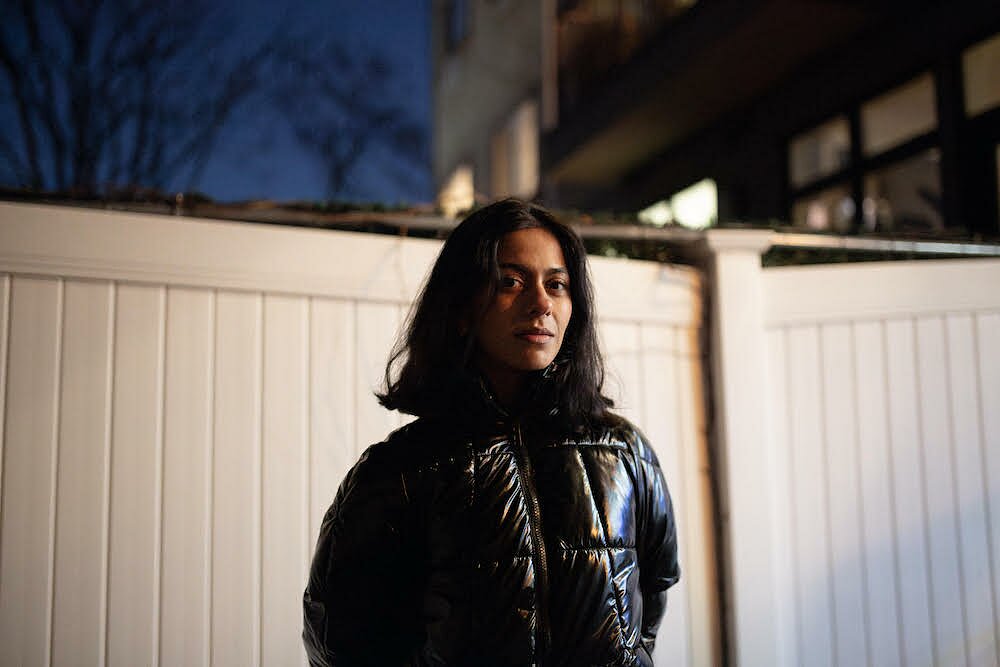Musician Arushi Jain’s Hard-Earned Joy
When I met musician Arushi Jain on a cold, bright morning in Brooklyn’s Bed-Stuy back in February, she was still a month and a half away from releasing her sophomore album, Delight, but she was already itching for something new. “I’m bored,” the experimental electronic composer confessed at one point in our conversation. “I’m bored of writing ambient music. I’m…a little bored.”
Sitting across from Jain, who wore a chunky emerald turtleneck and carried a bright yellow mesh bag, I was struck by her sense of curiosity. She went on to explain her love for the “research mode” of a project, when she can really focus on the process of learning. “How would I make this bend happen?” she asked, describing some of the questions that excite her most during the start of the composition process. “Is it possible for me to connect this instrument to that one with really low latency? Where is my information being stored?”
She presented a series of well-defined theses about herself that she shared often: “I’m the kind of person who gives herself a really impossible task and then locks herself up in a room and does it.” But just as quickly as she defined herself or her process, Jain would flip whatever information she knew on its head to see what new insights she could glean. She didn’t use much percussion in Delight, for example. Now that the project is done, she has immediately started thinking about how to make her music harsher and more distorted.
Delight is the result of this drive towards re-invention. Her 2021 debut album, Under The Lilac Sky, was a collection of airy synth arrangements and Hindustani classical melodies that are meant to be heard at sunset. While the tracks were certainly experimental, Jain’s bright vocals and the cascading, full arrangements keep them feeling honeyed, melodic, and propulsive. Meanwhile, with Delight, Jain pays more attention to the bass and low end layers of the composition, which give these songs a newfound graininess. The melodies are less defined track to track and her vocals are more distorted and sampled, often arriving in blips and bursts.
In Indian classical music, raags (analogous to scales) have specific emotions, seasons, or times of day associated with them. And, while Under The Lilac Sky featured an array of compositional styles and melodic tones, Jain challenged herself to stick to one raag on Delight, and to pull at different threads of emotion within it. Bageshari, the raag Jain composed within on Delight, is meant to relay the sense of longing that comes from separation from a lover. It’s an inherently relational sentiment, but on Delight, Jain sees the separation as one with herself. “The longing doesn’t have to be for another person,” she explained. “It could be a connection you have to yourself in a particular state of being. It could be, ‘I love playing the piano and I miss it like crazy because I hurt my hand.’ For me, a large part of delight comes from being able to find a private sense of joy.”
In Under The Lilac Sky, songs were offered as a guide to observing the beauty of the setting sun. They were made with an implicit audience in mind. In Delight, the songs are less about presenting delightful, joyous sounds to the listener than about documenting the work of cultivating inner happiness. They sound more introspective, spacier, and less neatly packaged.
Jain grew up in a big family in New Delhi, India. Her father was the youngest of seven children, so, by extension, she was one of the youngest of fifteen cousins. She describes her family as having “Von Trappy energy.” The arts were encouraged, almost as a responsibility—a way of becoming a well-rounded person. The kids in her family were always putting on dance competitions and plays. Even now, when she goes home, family members are constantly playing the Indian singing game Antakshari.
The greatest influence her upbringing had on her is that she learned to speak her mind. “When you grow up around a lot of children who are competing for the same thing, you have to figure out how to say what you want,” she said. This sense of assertion, of taking control over one’s own destiny, came up often in conversation with Jain. “You have to be observing the world,” she said. “If you’re not paying attention to what’s happening around you and not actively looking for things to bring you joy, you’re not going to find it. It takes work.”
Jain takes an active role in seeking out joy, in asking questions and working to answer them, and in constructing and deconstructing her sense of self. At the age of 18, Jain moved to the US to study computer science and artificial intelligence at Stanford University. For a few years, she stopped singing. “I thought that I was not supposed to do that type of thing anymore because I was here to study computer science and be around all this entrepreneurial Kool-Aid,” she said. But after taking a gap year before her senior year, she found her way back. “I just realized that music was a tool that I had within my reach at all times to steer my emotional self into the direction I wanted it to go,” she said. “I just decided I would do something about it.”
During her senior year, she decided to take a class called “Laptop Orchestra” at the Center for Computer Research in Music and Acoustics (CCRMA). It was a musical interfaces class where she learned the building blocks of sound synthesis. Students in the class used a programming language their professor had written to create their own instrument which they then performed with in class. “These classes introduced me to a world of endless possibilities where I could connect anything with anything,” said Jain.
After graduating, she started working in tech and, in her free time, used synthesizers that had a lot of pre-patching to make music. After a while she felt—in what seems to be a recurring sentiment in her life—bored with how restrictive the compositional options were compared to what she had learned at CCRMA. When someone showed her the modular synth, with all its infinite possibilities for customization, she found the instrument and musical freedom she was looking for, guiding her compositions to this day.
Writing music has allowed Jain to nurture and access her wide range of life experiences. When she first moved to the US, she felt guilty for leaving India, “I worried that I gave up my Indianness, that I thought less of it,” she said. But, through composing music that pulls from Indian classical singing traditions and morphs them into new, glitchier sounds, she realized that she didn’t need to think about identity in such a binary way: rather than belonging to one culture and renouncing the other, she started to see her connection to place as something that was innate rather than geographical.
“There’s this idea of a third world which can only exist because you have roots in multiple places,” she said. “You are the sum of your experiences and you cannot forget what you know, even when you’re not in the world [where you learned it]. I might be physically here but I’m actually in a third [place]. Writing music was me giving myself permission to inhabit the whole world.”
After releasing Under the Lilac Sky in 2021, Jain found herself in a period of restlessness and anxiety. She had moved from San Francisco to New York City and, a year in, was still having a hard time settling. She had quit her tech job to work on music full time, but was struggling to write in the city. She was also feeling the broader impacts of the pandemic while dealing with a hand injury. So, she turned her attention to cultivating delight.
Jain rented a house on Long Island for a month in October of 2022 to compose the songs on her new album. She told everyone she wasn’t reachable and spent the time there alone, waking up at 5 am, doing vocal practices, riaz (a daily musical practice in Hindustani Classical music), eating healthy foods, going for walks, and working on the album. By the time she left, she had most of the melodies and arrangements written.
Composed solely on a modular synth without any acoustic recordings woven in, Jain’s initial recordings felt too machine-like to her and didn’t quite capture the bucolic surroundings in which they were made. After a month of isolation, Jain was also eager to work with other people again. So, she restructured the whole album. She made room for her vocals and incorporated instrumental samples of guitar, saxophone, flute, and marimba, intentionally recording them in a way that sounded organic.
“When you play the saxophone, you’re supposed to point the mic on the musician’s hand, because that’s where you get the most sound from,” she explained. “When you put the mic in front of the air cavity, you get the sound of literal air blowing out. I wanted to create wind because it was so windy [at the house where I composed the music.]”
The introspection Jain cultivates in Delight is not to be confused with solitude or loneliness. Her sense of self comes from keenly observing beauty and then bringing her findings inward. You hear her curiosity and wonder in the music: There’s the transcendence of her glittering vocals on the track “Portal to Silver Livings” and the twisting, acidic flute and synth duet on “Imagine An Orchestra,” inspired by the vibrant back- and- forth between violinist Yehudi Menuhin and Indian sitar player Ravi Shankar on the 1967 record, West Meets East. The echoing saxophone on “I Surrender” evokes a geologic sense of yearning, the kind of deeply burrowed feeling you know humans have experienced for generations.
Light streams into the cafe in thick triangles that ebb across the wall as our conversation progresses. We chat for a few hours but Jain never loses her focus or animation as she talks about working in various programming languages to create music, discovering the tools that help her access happiness, and making art rooted in synthesizing multiple cultures. As she speaks, she often uses an unwrapped straw to trace out words on the table or to excitedly gesticulate like she is conducting a symphony. In the midst of explaining these ideas she has explored so thoroughly she adds, “I think everything is an experiment,” opening herself up to everything she has yet to learn.
–Vrinda Jagota is a writer living in Brooklyn. Her interests include, in no particular order, South Asian American music, Taylor Swift, and trying to understand why everyone started self-identifying as an empath a few years ago.


